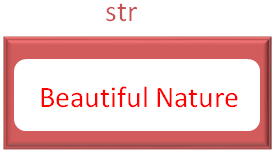

Special Sequences in Regex are something that helps us write the patterns quite easy to write.
They begins with \ and are followed by a letter giving a special meaning to it.
Let us see them below :
"Beautiful Nature"
fun main(args: Array) { var str = "Beautiful Nature" var x = Regex("\\AB") val match = x.find(str) var data = match?.value println("The String ::Beautiful Nature:: starts with :: "+data) }
var str = "Beautiful Nature"

var x = Regex("\\AB")\AB
println("The String ::Beautiful Nature:: starts with :: "+data)The String ::Beautiful Nature:: starts with B
"Beautiful Nature"
fun main() {
var str = "Beautiful Nature"
var x = Regex("\\bBea")
val match = x.find(str)
var data = match?.value
println("The String ::Beautiful Nature:: starts with :: "+data)
}
The String ::Beautiful Nature:: starts with :: Bea
var x = Regex("\\bBea")"Beautiful Nature"
fun main() {
var str = "Beautiful Nature"
var x = Regex("\\BBea")
var result = x.containsMatchIn(str)
if (result) {
println("The String ::Beautiful Nature:: starts with Bea")
}
else {
println("The String ::Beautiful Nature:: does not start with Bea")
}
}
The String ::Beautiful Nature:: does not start with Bea
var x = Regex("\\BBea")fun main() {
var str = "Beautiful Nature"
var x = Regex("\\Bful")
var result = x.containsMatchIn(str)
if (result) {
println("The String ::Beautiful Nature:: starts with ful")
}
else {
println("The String ::Beautiful Nature:: does not start with ful")
}
}
var x = Regex("\\Bful")The String ::Beautiful Nature:: does not start with ful
"Beautiful Nature"
fun main() {
var str = "Beautiful Nature"
var x = Regex("\\d")
var result = x.containsMatchIn(str)
if (result) {
println("The String ::Beautiful Nature:: has a number in it")
}
else {
println("The String ::Beautiful Nature:: does not have a number in it")
}
}
var x = Regex("\\d")
Didn't find a match.fun main() {
var str = "Beautiful Nature 92"
var x = Regex("\\d")
var result = x.containsMatchIn(str)
if (result) {
println("The String ::Beautiful Nature 92:: has a number in it")
}
else {
println("The String ::Beautiful Nature 92:: does not have a number in it")
}
}
str = "Beautiful Nature 92"
var x = Regex("\\d")The String ::Beautiful Nature 92:: has a number in it
"Beautiful Nature"
fun main() {
var str = "Beautiful Nature"
var x = Regex("\\D")
var result = x.containsMatchIn(str)
if (result) {
println("The String ::Beautiful Nature:: has a number in it")
}
else {
println("The String ::Beautiful Nature:: does not have a number in it")
}
}
var x = Regex("\\D")
Found a match."Beautiful Nature"
fun main() {
var str = "Beautiful Nature"
var x = Regex("\\s")
var result = x.containsMatchIn(str)
if (result) {
println("The String ::Beautiful Nature:: has a white space in it")
}
else {
println("The String ::Beautiful Nature:: does not have a white space in it")
}
}
var x = Regex("\\s")
Found a match."Beautiful Nature"
fun main() {
var str = "Beautiful"
var x = Regex("\\S")
var result = x.containsMatchIn(str)
if (result) {
println("The String ::Beautiful Nature:: has a white space in it")
}
else {
println("The String ::Beautiful Nature:: does not have a white space in it")
}
}
var str = "Beautiful"
var x = Regex("\\S")The String ::Beautifu:: does not have a white space in it
"Beautiful Nature"
fun main() {
var str = "Beautiful Nature"
var x = Regex("e\\Z")
var result = x.containsMatchIn(str)
if (result) {
println("The String ::Beautiful Nature:: ends with e")
}
else {
println("The String ::Beautiful Nature:: does not end with e")
}
}
var x = Regex("e\\Z")The String ::Beautiful Nature:: ends with e